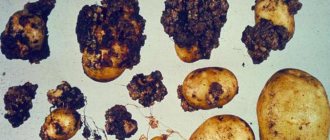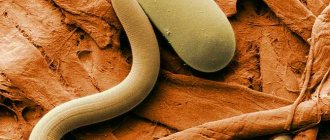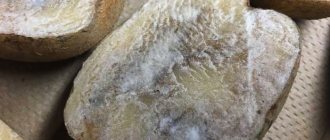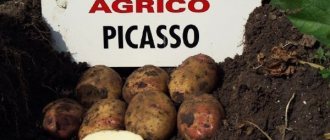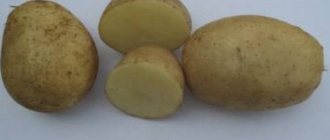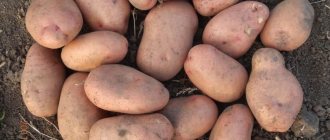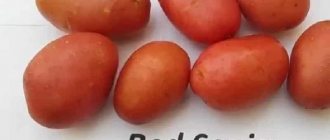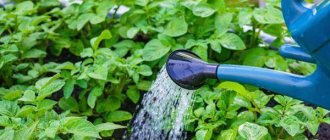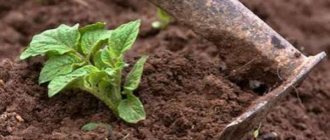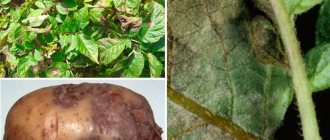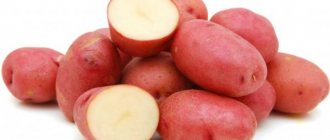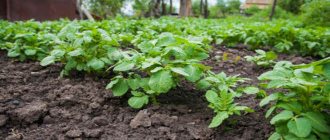Home / Pests and diseases
Back
Published: 10/22/2019
Reading time: 8 min
2
Ring rot can destroy half the potato crop. However, you shouldn’t get upset ahead of time, since even beginners in gardening can prevent it.
- 1 General information about the disease
- 2 External manifestation of potato ring rot
- 3 Forms of the disease
- 4 When does it develop?
- 5 How to protect potatoes
- 6 Preparations for prevention
Nature of the disease
The causative agent of potato ring rot is the bacterium Corynebacterium sepedonicum. It does not live in the soil - soil microflora displaces the infection from the site. But tubers are an excellent place for reproduction and wintering.
Under certain conditions, bacteria begin to migrate from mother potatoes to the tops. By filling the vessels of the stems, the pathogen provokes their blockage. As a result, the leaves do not receive enough moisture and wither. Decay is accelerated by toxins released during the life of pathogens.
The disease develops in any weather conditions. At moderate temperatures and a humid climate, wilting occurs more slowly than in the hot, dry season.
Blackleg
Bacterial diseases of potatoes - blackleg, ring rot and wet rot of potato tubers - are found everywhere and cause significant damage to it both in the field and in storage.
The main signs of blackleg are observed soon after the emergence of potato shoots. Bacteria destroy the base of plant stems. The stem darkens, often rots in wet weather, the base of the stem becomes thin, a constriction forms at the border of diseased and healthy tissue, and the plant is easily removed from the soil (without roots).
In the tubers of the new harvest, bacteria - the causative agents of blackleg - penetrate through the stolons, so the defeat begins in the places where the tuber is attached to the stolon. Penetration of bacteria into tubers can also occur through cracks in the skin and through various mechanical damage. Therefore, when planting, you should avoid cutting the tubers.
Often diseases on potato tubers do not appear in the fall, during harvesting, but at a later time. Signs of blackleg tuber disease can be easily distinguished from damage by other pathogens. Rotting of the tuber begins from the point of entry of infection - from the stolon end of the tuber. The tuber tissue in the affected areas turns into a soft, mucous dark mass with an unpleasant odor. Later, a rotted cavity or hollow appears here.
The main source of infection is diseased planting tubers. In addition, bacteria can survive in plant debris. Overmoistening of the soil contributes to an increase in the percentage of diseased plants. Therefore, on heavy, structureless soils, the disease develops much more strongly than on light soils. Structural soils, on the contrary, help increase plant resistance to disease. In dry summers, with a lack of moisture and elevated temperatures, the development of the disease sometimes stops, and the tubers do not have external signs of damage, but carry a hidden infection that appears during storage or the next year.
Form and signs of damage
It is difficult to notice the presence of aerobic bacteria that have settled in tubers or stolons. If infected potatoes were planted in the soil, the disease can only be known by the condition of the above-ground parts.
Not the entire bush withers, but only a couple of stems, which very quickly fall to the ground. This is already a clear sign that rot has settled in the tuber (with other diseases, the affected tops remain in a standing position). The tips of the leaves acquire a brown tint, and the plates themselves become covered with white spots due to a lack of chlorophyll.
The signs of the disease can be presented step by step as follows:
- the top of the affected stem turns yellow and the leaves on it curl;
- the plates look mottled due to the fawn color that appears between the veins;
- the lower leaves on the bush wither, become thinner, their edges curl upward;
- the tops slow down the growth process and take on a dwarf appearance due to shortened internodes.
A characteristic sign of ring rot is a mucous mass of a yellow-fawn hue that fills the diseased stem. If a cut branch is placed in water, this substance will begin to flow out of it.
In the initial stage of the disease, potato tubers are no different from healthy ones. Therefore, signs of damage do not appear immediately. They can only be detected by cutting the fruit transversely. If infection is present, the vascular ring becomes yellowish and the potato tissue becomes soft.
How to identify the disease?
Also check out these articles
- Growing watermelons in a greenhouse
- Chick drinking bowls
- Melon variety Gulyabi
- The best varieties of sweet and bitter peppers for greenhouses
Ring rot can affect both the underground part of the potato (tuber) and the above-ground part (tops) throughout the entire period of growth and maturation of the crop.
The main signs of the disease are yellowing and wilting of the tops, rotting of the tubers
The main signs of the disease are yellowing and wilting of the tops and rotting of the tubers. Decay is slow and easy to identify. If you cut a potato, you can see a ring formed by bacteria, it is located above the peel. The skin of affected potatoes is usually soft and may exude a yellow, slimy substance when pressure is applied to it.
Specialized means to destroy infection
The action of no chemicals can completely destroy a ring rot infection if the infection has already begun. But slowing down the development of potato disease (or better yet, preventing it) is quite possible. Specialized drugs will help with this:
- mineral fertilizers containing nitrogen and potassium, applied during certain periods of crop development, help increase the immunity of potatoes against any bacterial infections;
- to reduce the spread of the disease in the area, they control insect pests (before and after flowering of the bushes); fields are treated with complex insecticides such as Shar Pei, Tanrek, Sirocco, Borey Neo;
- when sending potato seed fruits for storage, they should be treated with fungicides Quadris and Maxim; the biological product Gamair is also suitable;
- Before planting, it is recommended to treat the tubers with TMTD, using 2.5 liters of the substance per ton of potatoes.
In the latter option, precautions must be taken - the product is toxic. But it has a complex spectrum of effects - potato tubers receive protection not only from bacterial, but also other diseases.
Fusarium potato
This dangerous disease, also called dry rot, affects many vegetable crops. Potato fusarium is caused by the pathogen Fusarium oxysporum. This is a type of spore fungus that lives in the ground, on plant remains and on the skin of tubers. The pathogen penetrates into plants with rain moisture through the root system. As soon as the spores begin to actively develop, fusarium forms.
- planting seed potatoes infected with fungal spores;
- improperly prepared soil;
- violation of tuber storage conditions;
- refusal of crop rotation on the site for several years;
- adverse weather conditions;
- excessive pest attacks;
- deficiency of organic matter and mineral fertilizers in the soil.
The most dangerous period for the manifestation of the disease is the time of active formation and development of young tubers. A month after infection, the first signs of the disease appear. Visually you can see the following symptoms:
- leaves curl at the top of the bush;
- the stems change color and acquire a brown tint;
- the leaves begin to turn yellow, crumble, and dry out;
- the stems droop to the ground and rot.
- fusarium of potato on tubers appears in the form of dry brown or gray-brown spots (rot);
- the potato peel becomes wrinkled, and voids form inside the tuber.
- The structure of the tuber core changes (it becomes dry and porous).
Potato Fusarium: how to treat
To treat this disease, two groups of drugs are used: chemical and biological. During the growing or storage period, you can treat potatoes with chemical protection agents such as Titus, Vist, Maxim. Opponents of chemistry resort to the help of biological drugs. Fitosporin-M, Integral, Baktofit have proven themselves well. They are used before planting seed potatoes in the soil. All these remedies are very effective in combating fungal diseases. They are sold in specialized stores; before use, they are diluted in water according to the instructions.
Potato fusarium and its control
Of course, it is easier to prevent a disease than to spend energy, time and money on fighting it. Therefore, it is better to take some preventive measures. This:
- planting healthy seed potatoes;
- purchasing varieties that are immune to dry rot;
- treating tubers with fungicides before planting and storing;
- compliance with crop rotation;
- timely destruction of infected plants (at the initial stage);
- thorough disinfection of the soil when a disease is detected;
- application of mineral fertilizers and organic matter in optimal quantities.
Such preventive work will help prevent the appearance of fusarium on the site.
Popular measures of struggle
Farmers do not have recipes for using improvised means to destroy the causative agent of the disease. The main measures to combat potato ring rot are as follows:
- compliance with crop rotation rules;
- use of green manure;
- drying the tubers.
To avoid potato damage by any disease, you should not plant the crop in one place year after year. But if this is not feasible due to limited space, then green manure will take on the bulk of the bacteria.
For this purpose, crops with a short development period are selected so that they have time to build up green mass before frost. It is best to immediately sow cereals (spike beans and corn), cabbage, legumes or tobacco on the site after harvesting potatoes.
Potato melanosis
What is potato melanosis? The second name for this disease is gray spotting, and it is not by chance that it is called that way. When cutting a potato, dark gray spots with blurred boundaries are visible in the pulp. They do not look like ulcers like in previous diseases, they are more like bruises. The darkened areas do not change either the structure or the smell, only the color of the pulp changes.
Potato melanosis: causes
Why does the pulp of tubers darken? There are several provoking factors.
- As a rule, gray spot occurs as a result of improper behavior with tubers. For example, when digging, potatoes were thrown forcefully into metal buckets or plastic containers. Or, during transportation, the potatoes hit the sides of the truck.
- Another important reason for the occurrence of melanosis is a lack of microelements in the soil. Especially when it lacks potassium. An excess of nitrogen also leads to the same results.
- Late harvesting of varieties with a high percentage of starch also leads to the appearance of gray spots in the pulp. For example, Lorch or Epicurus were left in dry, hot soil for too long, causing the starch to begin to darken.
- An excess of manure also has a negative effect, especially fresh manure added in the spring. When applying manure, the quantitative indicators of nitrogen immediately increase.
- Early harvesting also provokes the appearance of gray spot. Young thin skin is not able to reliably protect the pulp from external factors.
Potato melanosis: you can eat damaged tubers
Tubers affected by gray spot are suitable for consumption. The only problem is peeling the diseased potatoes. To rid the flesh of “bruises”, you will have to tinker a little. But if something remains, it’s okay, dark spots do not affect the taste, nor do they affect human health.
So, potato melanosis is not a fungal disease. If you eliminate all of the above reasons, then gray spotting can be easily avoided.
Prevention
Since root rot cannot be destroyed in the beds, the main efforts are directed towards preventive actions. Only a set of measures can prevent the development of the disease.
- For planting, varieties that are more resistant to rot are selected (Voltman, Korenevo, Peredovik). In this regard, early ripening potatoes have weak immunity.
- Only beautiful, firm tubers without any damage should be planted. The fruits are sent to the ground whole, without cutting, so as not to provoke infection.
- Having discovered a diseased bush on the site, it is completely dug up and, together with a lump of earth, taken away from the site.
- In dry weather, do not forget to water the potato bushes.
- To maintain plant immunity, fertilize in a timely manner.
- A week and a half before harvesting the potatoes, the tops are mowed and removed from the garden.
- All equipment used when planting and harvesting potatoes is disinfected with formaldehyde or washed with soapy water and wiped dry.
- It is mandatory to treat the storage - walls, floors, racks, drawers. Wooden structures should be replaced with metal ones.
- It is not allowed to store planting potatoes together with tubers intended for food.
If you carefully examine the seed potatoes, as well as the tops that have sprung up in the garden, and take timely measures to combat ring rot, this will save most of the crop from infection. Compliance with the rules of agricultural technology and disinfection of the soil after harvesting contribute to the protection of potatoes.
Potato blight
Another equally unpleasant disease of this vegetable crop. It is also called button rot or phomosa disease. Potato blight is caused by the fungus Phoma exiqua. Its spores parasitize stems and tubers. They are transferred from a diseased plant to a healthy one by airborne droplets. In addition, fungal spores can live in the soil and penetrate the cells of roots, stems and leaves with rainwater.
Manifestations of the disease
There are three forms of Phomaz:
- stem;
- stolon;
- tuberous
The stem form of the disease begins to actively manifest itself at the end of the flowering period. Small necrosis appears on the stems, turning into spots 10 cm long, which gradually spread around the entire circumference. As a result, the stem breaks off and dies.
In the stolon form, potato stolons are affected. Superficial dark brown spots turn into deep ulcers, while the affected parts of the roots die, and the rest do not produce many potatoes.
The tuberous form is the most common. The first signs of the disease appear only 3-4 weeks after harvest. Sometimes active rotting begins after 6-7 months, already in the spring, when the planting material is planted in the ground. Such potatoes do not germinate; they rot completely. First, dark, hard, slightly depressed spots form on the peel. Gradually they increase in depth and around the perimeter. Outwardly, it looks as if the flesh was pressed in with a button. The surface of the ulcer is dry and papery. If you press on it with your finger, it will crumble into powder. This is the mycelium of the pathogen with black dots of pycnidia.
Treatment of the disease
Potato blight is a fungal disease, so it needs to be treated with the same drugs as fusarium. It is important to suppress outbreaks of disease, improve winter storage conditions for crops, and regularly prevent infection of tubers.
Potato blight: control measures
Simple measures will help prevent the massive spread of fungal spores. Crop rotation will reduce the percentage of pathogen spores in the soil. To prevent the stem form of Phoma from spreading to the tubers, the tops must be cut off 10 days before the expected harvest. In the spring, before planting, you must carefully sort through the seed potatoes and mercilessly remove all spoiled specimens. Stems should be sprayed with fungicides before flowering. Before storing potatoes in a cellar or basement, the storage must be removed, the walls must be whitewashed with lime, and the racks must be washed with disinfectants. Thanks to these measures, potatoes will never be affected by button rot.
